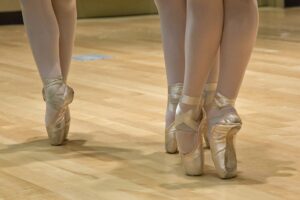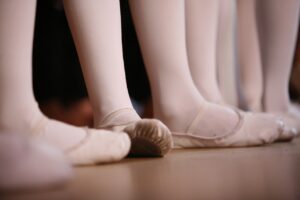Did you know that ankle injuries are amongst the most common injuries seen in ballet dancers??? I’m guessing you probably did, because we’ve all either hurt an ankle ourselves, or have seen somebody else roll right over the side of their foot, only to end up watching class in a moon boot for a couple of weeks, right!? As potential primas, it’s important that we work on building ankle strength for ballet to not only avoid injury, but to also improve our technique, balance and confidence when dancing en pointe! Let’s get started, shall we?…
Okay, so our ankles are made up of TONS and TONS of muscles and ligaments, however for your benefit (I don’t want to keep you here reading this all day), we will focus on four structures which are very important to us as ballet dancers. It’s essential that we strengthen the WHOLE ankle and lower leg (not just the outer portion where our ‘ankle bone’ is) to ensure maximum stability and to avoid muscle imbalances!
Before we whip our resistance bands out of our sweaty, smelly dance bags and get cracking with the exercises, I’m going to give you a brief insight into the anatomy of your ankles and lower legs, so that you can understand the benefits of each exercise, and how they will collectively help you to build ankle strength for ballet…

#1 – Tibialis anterior (Dorsiflexion)
Located in the front of our lower leg, we use the tibialis anterior to flex the foot. As dancers, we spend so much time en relevé or demi pointe which uses our calf muscles (the gastrocnemius and soleus muscles), and this can lead to muscular imbalances, and conditions such as shin splints, if we forget to strengthen the muscles in the front of our lower legs too!
Strengthening the tibialis anterior is also a great way of building ankle strength for ballet because it allows us to get deeper into our pliés, resulting in higher jumps when we push off from the plié position. The tibialis anterior also prevents injury by acting as a shock absorber when we land from jumps!
Dorsiflexion is a great way of strengthening the tibialis anterior…
Step 1 – Sit on the floor with your legs extended straight out in front of you.
Step 2 – Tie a resistance band in a loop around a chair leg which is located in front of you beyond your foot, and the upper portion of your relaxed foot.
Step 3 – Slowly flex your foot so that your toes come towards your shin. You should feel some resistance against your foot from the resistance band.
Step 4 – Slowly relax your foot by moving it away from your shin back to the original starting position. Repeat, remembering to make the whole movement slow and controlled throughout!
#2 – Tibialis posterior (Resisted relevé, foot inversion)
The tibialis posterior is located towards the back of the lower leg and helps to prevent pronation (the rolling in of our feet) which is common when we plié or turn our feet out. The tibialis posterior prevents pronation by providing arch support, where it keeps the arches of our feet supported, stabilised and lifted so that they don’t roll in! It also provides support when we land from jumps.
There are two amazing exercises that you can do to strengthen the tibialis posterior to build ankle strength for ballet…
Resisted relevé
Step 1 – Stand on one leg with a resistance band tied in a loop around your ankle and a chair leg placed behind you.
Step 2 – Slowly rise up en demi pointe against the resistance. You may feel like the resistance band is trying to pull you back down.
Step 3 – Lower from demi pointe and repeat.
Foot inversion
Step 1 – Sit on the floor with your legs extended straight out in front of you.
Step 2 – Wrap a resistance band in a loop around the upper portion of your left foot and a chair leg which is located on the outside of your left foot.
Step 3 – Keeping your leg still and your knee facing upwards, slowly rotate your left foot inwards from the ankle.
Step 4 – Return your foot to the starting position and repeat.
#3&4 – Peroneus longus and peroneus brevis (Winging)
The peroneus longus and brevis are located on the outside of our lower legs, and they are two of the key muscles we need to focus on when building ankle strength for ballet. Not only are they responsible for turning the feet out (although most of our turn out SHOULD come from the hips, studies show that around 15 degrees of our turn out comes from the feet), they can also be strengthened to prevent supination.
Supination is the rolling out of our feet and ankles, and it often occurs when we stand en demi pointe if we are lacking strength in our peroneus longus and brevis. If our feet or ankles roll out when we relevé to pointe, it becomes very easy for us to sprain or damage ligaments in the ankle.

If you have been have been seeing loads of ballerinas with a slightly upwards-tilted foot on the end of their arabesque, then guess what… this is known as winging! Strengthening your peroneus longus and peroneus brevis will have help you to achieve that stunning winged foot so that you too can be the envy of bunheads far and wide!
Winging
Step 1 – Sit on the floor with your legs extended straight out in front of you.
Step 2 – Wrap a resistance band in a loop around the upper portion of your left foot and a chair leg which is located on the inside of your left foot.
Step 3 – Keeping your leg still and your knee facing upwards, slowly rotate your left foot outwards from the ankle.
Step 4 – Return your foot to the starting position and repeat.
Final thoughts of building ankle strength for ballet
Our feet and our ankles are incredibly important to us as dancers, and without them we wouldn’t be able to perform. Therefore, it is essential that we keep them as strong as possible, and we can do this by training all of the key muscles of our ankles and lower legs to avoid imbalances and injuries.
Building ankle strength for ballet also enhances our technique by improving our ability to balance, which leads to greater confidence when dancing en pointe! We all know how impressive it can be when a dancer holds a posé arabesque en pointe for what seems like forever, and great ankle strength (combined with a strong core) is your key to being able to wow the crowds with these beautiful balances too!
Not tired out yet? If you’re wondering how you can build strength in your feet as well as your ankles, head over to my article THE BEST FOOT STRENGHTENING EXERCISES FOR DANCERS. See you there, bunhead besties!
**FRIENDLY DISCLAIMER: All information, guidance or advice provided on this site is for informational and educational purposes only. The use of this information is at your own risk. **
Bibliography and References
Some of the concepts included in this article have been clarified and informed by OpenAI’s ChatGPT (OpenAI, 2023)
Open AI, 2024. ChatGPT [November 2023]. Available at: https://www.openai.com/chatgpt [Accessed 15 November 2023].